Ibike Korea People-to-People Program
 Photo essay: Yeongsan
River -
Photo essay: Yeongsan
River -
Damyang, Gwangju
Yeongsan River Trail, (130 km, 80 mi) Mostly riverside and dike-top trail, with the occasional
headland.
Points of Interest: beautiful hills, rivers and valleys, Damyang "Bamboo
Town" and Gwangju "Art Town of Korea".
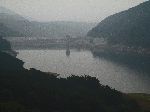
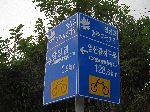
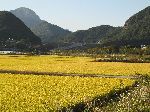 The northeastern, upstream, terminus of the Yeongsan River Trail is at
Damyangdam, with Damyangho
(lake), less than 10 kms north of Damyang. Seen to the left "in the land
of the morning calm" a slogan of Korea, which in the fall is often accompanied
by some fog.
The northeastern, upstream, terminus of the Yeongsan River Trail is at
Damyangdam, with Damyangho
(lake), less than 10 kms north of Damyang. Seen to the left "in the land
of the morning calm" a slogan of Korea, which in the fall is often accompanied
by some fog.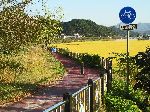
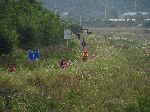
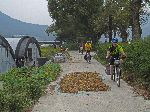 The
trail starts out passing rice fields and fields of flowers. An alternative route
runs through the middle of the rice fields and farming communities.
The
trail starts out passing rice fields and fields of flowers. An alternative route
runs through the middle of the rice fields and farming communities.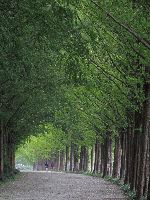
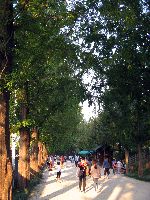
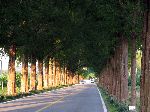
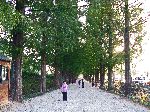 Parallel the river, near Damyang are 4 kms of Metasequoia
trees (a relative of cypress and cedar) that were planted along the Rd 24 in the early 1970s when the Ministry of
Internal Affairs officially designated the road as a “boulevard.” At that time,
the
saplings were only 3 to 4 years old and their branches stretched sparsely out
into the sky; now, the trees have grown so high that they seem to block out the
sun! Thanks to these stately trees, in 2002 the Korea Forest Service selected
the boulevard as one of the most beautiful roads in Korea. Part of the
colonnade of trees can be enjoyed on foot and part of it still lines the road.
Parallel the river, near Damyang are 4 kms of Metasequoia
trees (a relative of cypress and cedar) that were planted along the Rd 24 in the early 1970s when the Ministry of
Internal Affairs officially designated the road as a “boulevard.” At that time,
the
saplings were only 3 to 4 years old and their branches stretched sparsely out
into the sky; now, the trees have grown so high that they seem to block out the
sun! Thanks to these stately trees, in 2002 the Korea Forest Service selected
the boulevard as one of the most beautiful roads in Korea. Part of the
colonnade of trees can be enjoyed on foot and part of it still lines the road.
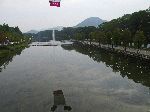
The adjacent Gwanbangjerim forest is also engineered. The first trees were planted along the river Seong Iseong (the vice envoy to Damyang) in 1648, during the Joseon period (1392-1910), in a response to annual flooding. In 1854, 30,000 workers were mobilized to improve the river bank and forest. The forest now occupies a huge are from Mt Chuwol and Yongchu Peak on the north; Mt Gwangdeok to the east; and Deokjin Peak, Mt Bonghwang, and Mt Gobi to the south. Seong Iseong was honored posthumously for his clean-handed work during his tenure. Because of this Gwanbangjerim is said to be imbued with the spirit of pure love and love for the common people.
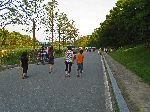
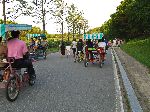
The Gwanbangjerim and Yeongsan River Trail attract a mix of walkers (from
infants to elderly), beginning bicyclists and oversize quad-cycles. They all
seem to have a propensity to swerve and turn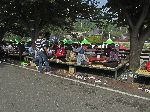 hastily, without check to see who might be in the space they are moving into,
nor without any signal or indication they intend to change position on the
trail. Fortunately most of the crowd is moving pretty slowly, but it still pays
to stay alert.
hastily, without check to see who might be in the space they are moving into,
nor without any signal or indication they intend to change position on the
trail. Fortunately most of the crowd is moving pretty slowly, but it still pays
to stay alert.
To keep the active visitors happy the top of the dike is lined with restaurant, which provide tables over looking the river.
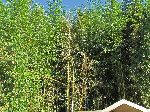
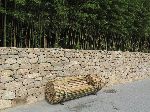
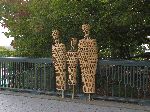 Another noteworthy forest near Damyang is the Bamboo Forest.
Damyang considers itself to be the bamboo capital of Korea. Consequently it is
the venue for the annual bamboo festival and biennial International Bamboo Expo,
with all manner of things bamboo.
Another noteworthy forest near Damyang is the Bamboo Forest.
Damyang considers itself to be the bamboo capital of Korea. Consequently it is
the venue for the annual bamboo festival and biennial International Bamboo Expo,
with all manner of things bamboo.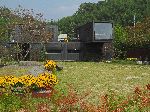
Damyang has also become a magnate for creative people in general and several artists have built houses and studios here.
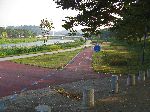
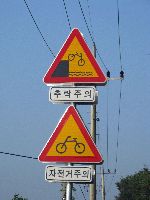
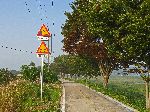 Continuing
southwest, away
from the built-up area the trail is smaller. Initially separate lanes for
wheeled and non-wheeled modes (left), and further out, one lane for everyone to
share (right).
Continuing
southwest, away
from the built-up area the trail is smaller. Initially separate lanes for
wheeled and non-wheeled modes (left), and further out, one lane for everyone to
share (right).I am always a fan of the caution sign that has the bicycle launching itself off of an embankment (right).
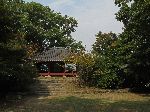
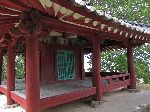 On the hill in
the forest is the rather modest seeming Myeonangjeong (pavilion) of Song Sun (1493-1592). The complex
was built after Song
On the hill in
the forest is the rather modest seeming Myeonangjeong (pavilion) of Song Sun (1493-1592). The complex
was built after Song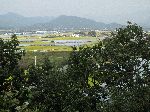 retired for government service. Song hardly retired.
The pavilion hosted discussion on national affairs with other prominent scholars
and was a study hall for many up and coming young scholars. (It has been
restored many time.)
retired for government service. Song hardly retired.
The pavilion hosted discussion on national affairs with other prominent scholars
and was a study hall for many up and coming young scholars. (It has been
restored many time.)It has an expansive view. It is all personal preference, but unfortunately the view is not improving over time.
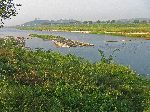
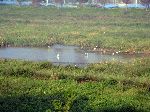 Generally
the river doesn't have much drop to it in this section, but this means that
the trail is very flat as well. The flow of the river is further
reduced by low weirs that cross it. These are supplement by fish ladders
(left).
Generally
the river doesn't have much drop to it in this section, but this means that
the trail is very flat as well. The flow of the river is further
reduced by low weirs that cross it. These are supplement by fish ladders
(left).At low water there is a lot of marsh and wet land. It doesn't attract
as diverse a variety of bird life as I would have expected, but this might be
seasonal. There were
plenty of herons poaching a meal.
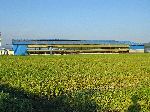
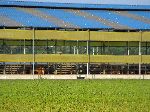 The
trail can be located in the flood plain next to the river or on top of the dike
parallel with the river. I tend to like the latter because the high vantage
point provides more diverse scenery, both of the river and the agriculture in the
area..
The
trail can be located in the flood plain next to the river or on top of the dike
parallel with the river. I tend to like the latter because the high vantage
point provides more diverse scenery, both of the river and the agriculture in the
area..At this point we passed a cow barn. In Korea, neither milk cows or beef cow graze in pastures. They are totally raised in barns -- often identifiable by there blue roofs and yellow siding.
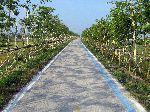
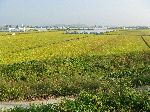
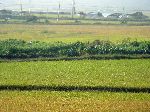
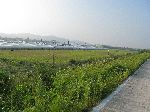
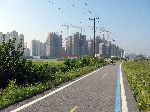
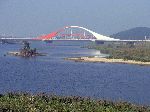 seven cranes in operation. It is only one of many such projects.
seven cranes in operation. It is only one of many such projects.If rivers create boundaries, bridges are what can re-connect people. In Korea, bridge do more than just bridge -- the design, art and architecture stand out as well. The bridge shown here is the Deokheungdaegyo.
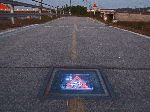
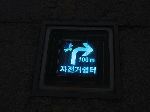
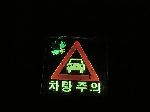 If
you have a late arrival you will learn that the
Yeongsan River Trail has a special feature near Gwangju in the form of imbedded
lighted signage. While the graphics are lighted at night, the trail itself has
no illumination and generally very faint or non-existant edges stripes.
If
you have a late arrival you will learn that the
Yeongsan River Trail has a special feature near Gwangju in the form of imbedded
lighted signage. While the graphics are lighted at night, the trail itself has
no illumination and generally very faint or non-existant edges stripes. 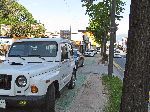
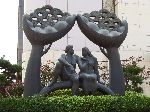
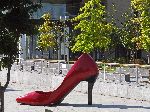 Gwangju
calls itself "Art Town of Korea." To support this claim there is Art Street,
Gwangju Culture & Art Center, Gwangju
Museum of Art, Gwangju Folk Museum, numerous specialty museums and gallery,
Gwangju Biennale and Gwangju Design Biennale (the last two from September to
November in alternating years.)
Gwangju
calls itself "Art Town of Korea." To support this claim there is Art Street,
Gwangju Culture & Art Center, Gwangju
Museum of Art, Gwangju Folk Museum, numerous specialty museums and gallery,
Gwangju Biennale and Gwangju Design Biennale (the last two from September to
November in alternating years.)Just passing Folk Museum and Art Museum, there were free, outdoor performances in traditional dance and gayageum (a traditional Korean zither-like string instrument, with 12 strings, though some more recent variants have 21 or other numbers of strings) [It is related to other Asian instruments, including the Chinese guzheng, the Japanese koto, the Mongolian yatga, and the Vietnamese đàn tranh.]
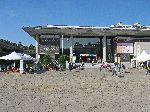
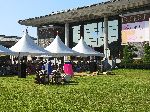
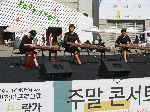
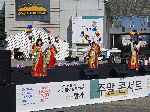
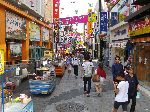
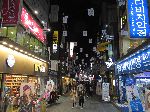 Chungjangno (Shopping street), named after the posthumous
title of General Kim Deok-ryeong, Chungjangno Street was the site of the 1980
Gwangju Democratization Movement. Today, it is Gwangju’s major fashion district,
comparable with Myeongdong Street of Seoul. The streets of Chungjangno are lined
with shopping malls, clothing stores, restaurants, cafes, movie theaters and
various other attractions, providing an intensive experience with the modern
culture of Gwangju. It is the city's hub of fashion -- trendy, traditional
and tasteless -- as
well as venue for diverse performances. And it doesn't slow down in the evening.
Chungjangno (Shopping street), named after the posthumous
title of General Kim Deok-ryeong, Chungjangno Street was the site of the 1980
Gwangju Democratization Movement. Today, it is Gwangju’s major fashion district,
comparable with Myeongdong Street of Seoul. The streets of Chungjangno are lined
with shopping malls, clothing stores, restaurants, cafes, movie theaters and
various other attractions, providing an intensive experience with the modern
culture of Gwangju. It is the city's hub of fashion -- trendy, traditional
and tasteless -- as
well as venue for diverse performances. And it doesn't slow down in the evening.
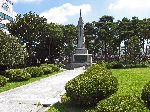
The same section of the backdrop to the Gwangju Democratization Movement, also known as Gwangju Massacre. This was a popular movement in the city of Gwangju, from May 18 to 27, 1980. Official reports acknowledge 170 people may have died. [At the time anyone who disputed the official death toll could be arrested. However, census figures reveal that almost 2,000 citizens of Gwangju disappeared during this time period.] During this period, citizens rose up against Chun Doo-hwan's dictatorship and took control of the city. In the course of the movement, citizens took up arms (by robbing police stations and military depots) to oppose the government, but were ultimately crushed by the South Korean army. The event is sometimes called 5·18 (May 18), in reference to the date the movement began. There is a mapped May 18 Historical Pilgrimage.
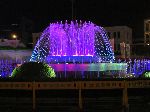
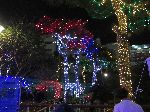 The
Chungjangno area doesn't slow down at sunset during much of the year. Lighted
fountains and trees keep it interesting and if the visit coincides with
The
Chungjangno area doesn't slow down at sunset during much of the year. Lighted
fountains and trees keep it interesting and if the visit coincides with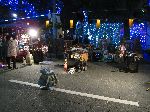 on of the many festivals there are likely to be street performances.
on of the many festivals there are likely to be street performances.The performance that had occurred at the location to the right was interesting. The musicians were South American Andean flute players, but they dressed in North American plains Indian ceremonial wear, including feathered headdresses and the set is decorated with pictures of native North American heroes and fashion accessories.
 Please
contact us if you would like to be added to
Ibike's mailing list or have questions, comments, corrections or criticism. (Also, please let us know how you learned about us and
found this site.) Privacy policy.
Please
contact us if you would like to be added to
Ibike's mailing list or have questions, comments, corrections or criticism. (Also, please let us know how you learned about us and
found this site.) Privacy policy.
![]() IBF Homepage
IBF Homepage ![]() Ibike Programs
Ibike Programs
![]() Ibike Schedule
Ibike Schedule
![]() Search
Search



